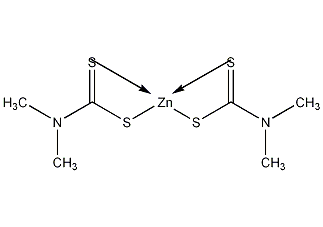
Structural formula
| Business number | 03RH |
|---|---|
| Molecular formula | C6H12N2S4Zn |
| Molecular weight | 305.83 |
| label |
Zinc dimethyldithiocarbamate, Accelerator ZDMC, Dimethyldithiocarbamic acid zinc salt, Ziram, zinc dimethyl dithiocarbamate, Aavolex,Carbazinc,Cymate,Fuclasin,Hexazir, Fungicide |
Numbering system
CAS number:137-30-4
MDL number:MFCD00064797
EINECS number:205-288-3
RTECS number:ZH0525000
BRN number:3707008
PubChem number:24869279
Physical property data
1. Appearance: white or light yellow powder. Non-toxic and odorless.
2. Relative density: 2.00
3. Melting point (ºC): 250
4. Solubility; soluble in chloroform, ammonia, carbon disulfide and dilute alkali Liquid, slightly soluble in water, ethanol and ether.
Toxicological data
Acute oral LD50 in rats is 1400mg/kg, which has an irritating effect on the skin, nasal mucosa and throat. Weanling rats are fed feed containing 100mg/kg There were no adverse reactions after feeding dogs for 30 days and at a daily dose of 5mg/kg for one year. Carp LC50 is 0.075mg/L (48h).
Ecological data
None
Molecular structure data
None
Compute chemical data
1. Reference value for hydrophobic parameter calculation (XlogP): None
2. Number of hydrogen bond donors: 0
3. Number of hydrogen bond acceptors: 4
4. Number of rotatable chemical bonds: 0
5. Number of tautomers: none
6. Topological molecule polar surface area 72.7
7. Number of heavy atoms: 13
8. Surface charge: 0
9. Complexity: 54.3
10. Number of isotope atoms: 0
11. Determine the number of atomic stereocenters: 0
12. Uncertain number of atomic stereocenters: 0
13. Determine the number of chemical bond stereocenters: 0
14. Number of uncertain chemical bond stereocenters: 0
15. Number of covalent bond units: 3
Properties and stability
Non-toxic and odorless. Crystals obtained from hot chloroform or ethanol are almost insoluble in water and gasoline, but have good wettability in water.
Storage method
Lined with plastic bags and packaged in polypropylene woven bags, placed in a ventilated and dry place. The storage stability period is two years.
Synthesis method
(1) Preparation of sodium dimethyldithiocarbamate. First, prepare the solid alkali into a 15% aqueous solution in the reaction kettle, and then Add carbon disulfide and dimethylAmine, heat slightly while stirring, keep the temperature at 40-45°C, and conduct condensation reaction for more than 1 hour. When the pH value of the system reaches 9 to 10, the resulting light yellow-green or amber liquid is sodium dimethyldithiocarbamate.

(2) Preparation of accelerator PZ: Add zinc sulfate or zinc chloride to the sodium dimethyldithiocarbamate prepared above, and control the temperature below 30°C while stirring , carry out metathesis reaction. The reaction product is filtered, dried, crushed and screened to obtain the finished product.

3.Dissolve sodium thiram in water, adjust the pH value of the reaction solution to 7.5-8 with dilute acid, and then react with zinc sulfate to form zinc thiram precipitate, which is obtained by filtering, drying, and crushing Thiram original drug. The yield is >97%, and the content is ≥93%.
Purpose
1. This product is used as a general accelerator for natural rubber, synthetic rubber and latex. Especially suitable for butyl rubber and nitrile rubber, and also suitable for EPDM rubber. The vulcanization temperature is about 100°C, and the activity is similar to that of the accelerator TMTD. However, the activity is stronger at low temperatures and has a greater tendency to scorch, which can easily cause early vulcanization during mixing. This product has an activation effect on thiazole and sulfenamide accelerators and can be used as a second accelerator. When used together with the accelerator DM, the anti-scorch performance increases as the amount of DM increases. This product vulcanizes slowly when used alone in latex, and is usually used in combination with other accelerators. This product is easily dispersed in rubber and is suitable for light and brightly colored products. It is mainly used in latex products, but can also be used in self-vulcanized glue, tape, and cold vulcanized products. In the United States, PZ has been approved by the Food and Drug Administration (FDA) for use in rubber products for food use. The general dosage in latex rubber materials is 0.3 to 1.5 parts.
2.Protective fungicides. It has inhibitory and preventive effects on diseases caused by various fungi, and also has the effects of stimulating growth and promoting early maturity. Used to prevent and control rice blast, bakanae, wheat rust, powdery mildew, potato late blight, black spot, cucumber, cabbage, cabbage downy mildew, tomato anthracnose, early blight, melon anthracnose, tobacco wilt Diseases include apple blossom rot, anthracnose, black spot, red spot, grape powdery mildew, anthracnose, pear scab, citrus canker, scab, etc. Generally, it is treated with 300-500 times of 65% wettable powder. Spraying before the onset or in the early stage has a preventive effect. Spray once every 5 to 7 days during the onset period, 2 to 4 times in a row. According to different diseases, the dosage and frequency of medication are different.

 微信扫一扫打赏
微信扫一扫打赏

